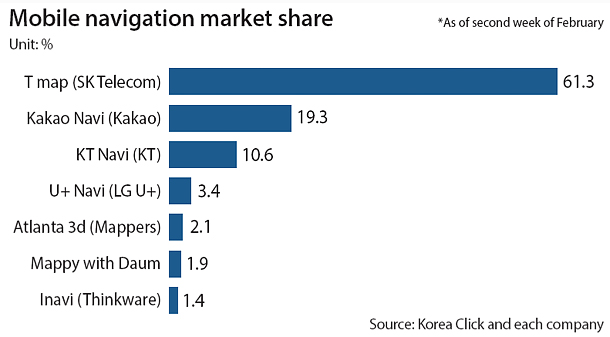Navigation is key to future cars

The car changed lanes and maneuvered onto expressways like an actual human being was behind the wheel. None of this can be done without the GPS, the most important technology for a self-driving vehicle.
This year marks the 15th anniversary of the introduction of the mobile navigation service. SK Telecom launched “Native Drive,” a mobile navigation service, for the first time in the country on Feb. 20, 2002.
The technology has developed significantly over the period.
“Not only telecommunication service providers but also large portal service providers are competing fiercely in the navigation market,” said Lee Jong-gap, a manager at SK Telecom’s T map department. “The competition will expand from the smartphone sector to connected cars and autonomous vehicle sectors.”
SK Telecom, which launched its T map service in 2007 when 3G networks were introduced, has developed connected car technologies with BMW. SK will announce a new autonomous vehicle business with the U.S.-based Nvidia at the Mobile World Congress 2017 held in Spain later this month.
Naver, the largest internet portal in the country, got government approval for its autonomous vehicle technologies using the company’s navigation system last year. The government believes autonomous vehicles will be commercialized in Korea in 2020.

Google purchased the Israeli map application Waze in 2013 and plans to commercialize self-driving vehicles this year. Volkswagen, BMW and Mercedes Benz acquired Nokia’s mapping service “Here” for 2.55 billion euros ($2.7 billion). China’s internet giant Tencent and Intel also invested in Here.
Before mobile navigation services were introduced, automakers and navigation manufacturers led the market. The Electro Gyro-Cator was the first analog-type navigation service developed by Japanese automaker Honda.
The first digital navigation device was the Etak, developed by a U.S. auto part manufacturer in 1985. The market grew rapidly starting from 2000, after military-use GPS was opened up to the public.
Japan was ahead of Korea in the first generation of navigation services, but Korea surpassed the Japanese technology in 2002. The telecommunication industry believes SK Telecom’s T map was the first mobile navigation service introduced in the world. T map offered basic services at first, but still provided users information of about 30,000 vehicles on roads and gave routes to destinations.

According to research firm Korean Click, T map accounted for 61.3 percent of total market share as of the second week of this month. It was followed by Kakao Navi at 19.3 percent and KT Navi at 10.6 percent. LG U+ is behind of the competition, accounting for 3.4 percent of the total mobile navigation service users.
The navigation market grew rapidly as more people started to use smartphones in 2010. Kakao and LG U+ entered the market starting from 2010.
As more people are using mobile navigation platforms, traditional navigation manufacturers are diversifying their business lines.
“We are finding ways to survive the competition by providing services like giving information on distances between other cars while driving, which is quite a difficult service for mobile navigation service providers,” said a representative of Fine Digital.
BY KIM DO-NYUN [kim.youngnam@joongang.co.kr]










with the Korea JoongAng Daily
To write comments, please log in to one of the accounts.
Standards Board Policy (0/250자)